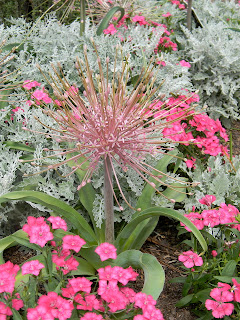When looking for our first house, the yard was an important aspect: we knew we wanted a large perennial border. We were lucky enough to find a home with, among other features, a South-facing fence in our garden that makes a perfect backdrop for our full-sun mixed perennial border.


When we moved into our house in January of 2009, the first thing we did when the ground was warm enough to dig was fix the drainage around the property. Snaking its way through the back of the border is a buried drainage pipe that is trouble to dig around, but helped lay the plans for our perennial border. Brian, being the landscape designer, drew out the curvy style of our beds, while I was left with my favorite task of filling it in with plants. A huge area to fill, it took us 2 seasons to complete our plant selections. Starting with some clearance shrubs and home-propagated native perennials we built it up steadily. With almost everything in since last summer, this year promises to be gorgeous. There is one more hole to fill in this area however, an arbor at the far end was taken out, leaving me with some more room to expand the sun-perennial collection... I dread the time when I run out of room to plant!
Another great advantage of our home is the raised back porch. It provides a perfect vantage point to survey and document the garden. The view from above provides a much different perspective, and makes it even more of a challenge designing plantings that look good from every angle. The result of such is usually planting things a little too close to fill in holes seen from above, leaving me no room to walk into planting areas for maintenance. But, that's the thing about your first house/garden: you make lots of mistakes and always learn from them. Anyway, the vantage point on the porch is perfect to take a series of pictures to see how the border progressed over the month of March and early April.
 |
| March 9th, 2011 |
 |
| March 20th, 2011 |
 |
| March 29th, 2011 |
 |
| April 4th, 2011 |
The growth rate of things amazes me this time of year. I swear the
Monarda grows an inch every night! As of now almost everything is up in the garden, with a few exceptions like fall perennials such as Joe Pye Weed. The Reeves Spirea (
Spirea cantoniensis) really stands out in this series, as the blooms progress from the back to the front, weighing down the branches.
The weight of the blooms on the Reeves Spirea are so heavy that the branches touch the ground in the front of the border, making a rare visit with the "Little Beauty" Tulips. What a beautiful meeting!
I had to include some close-ups of a few other standouts right now in the perennial border. The 'Double Dutch' Tulip is a standout from any angle, at any stage of bloom. From a too-bright-to-capture neon orange, to this rusty aged copper, this Tulip has to be one of my favorites.
The Roman Hyacinth (
Bellevalia romana) (left) was one of the first plants to go in the border. Bought on clearance and not planted until the end of January, these little guys have toughed through and are just now beginning to bloom. Not a standout from afar, it sure looks beautiful for its spotlight picture! The 'Stairway to Heavean' Jacob's Ladder (
Polemonium reptans 'Stairway to Heaven') (right), on the otherhand, is a standout from afar, and you can see its white new growth in the foreground of the perennial bored time-lapse pictures. Yesterday, the first little sky blue bloom appeared, and soon they will be covered in blooms. Perhaps one of my favorite foliage plants as well, these little guys had to be moved into their shadier location to prevent leaf scorch.
The Easter Rose (
Kerria japonica 'Honshu') (left) burst into bloom this week, and is setting many more buds for what looks like will be a long bloom time. I'm enjoying this new addition more and more every day, as the tropical looking flowers add a touch of summer to the spring pallet. The 'Wine and Roses' Wigelia (
Wigelia florida 'Wine and Roses') (right) was another standout in the pictures, as you can see the wine-colored foliage appearing in the center of the perennial border time-lapse pictures. What you can't see from those images are the swelling rose colored buds, covered in pollen, but still beautiful!
I will conclude with a bit of a misfit, as it is not in the sun perennial border, but the Wisteria is in full bloom and dropping its lilac-colored petals all over the garden. Tonight promises to be our last night below 45 degrees, very exciting times! Perhaps a trip to the garden center is in store for tomorrow...
"If you've never been thrilled to the very edges of your soul by a flower in spring bloom, maybe your soul has never been in bloom." ~Terri Guillemets























































